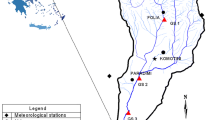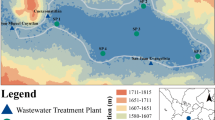Abstract
Water quality indices (WQIs) are efficient and powerful tools for evaluating, organising and communicating information on the overall quality of surface water bodies. The use of these indices may be very helpful in evaluating the water quality of aquatic systems in relation to the EU Water Framework Directive (WFD). In this study, two well-known water quality indices have been selected for evaluation: the CCME (Canadian Council of Ministers of the Environment) and NSF (National Sanitation Foundation). These WQIs were applied in the Polyphytos reservoir-Aliakmon river in Greece where monthly water quality data were available for the period June 2004 to May 2005. The available dataset included values of the following parameters: water depth, water temperature, dissolved oxygen, electrical conductivity, pH, transparency (Secchi disk depth), BOD5, COD, total phosphorus (TP), chlorophyll-a (Chl-a), ammonium (NH4 +), nitrite (NO2 −) and nitrate (NO3 −), and total Κjeldahl nitrogen (TKN). The application of the two WQIs was made using specialised, freely available software-tools. A comparison of their performance and a qualitative judgement on their suitability on expressing the quality of a surface water body is presented. The classification results were compared with those obtained by the WFD-ECOFRAME approach of the EU. Based on the applicability and drawbacks of the examined indices, useful conclusions were derived and discussed. Among others, it is concluded that the NSF-WQI is a more robust index and produces a classification nearer that of the WFD-ECOFRAME approach when compared to the CCME-WQI.




Similar content being viewed by others
References
Abbasi T, Abbasi SA (2012) Water quality indices. Elsevier, p, 363
Alexakis D (2011) Assessment of water quality in the Messolonghi-Etoliko and Neochorio region (West Greece) using hydrochemical and statistical analysis methods. Environ Monit Assess 182:397–413
Alexakis D, Kagalou I, Tsakiris G (2013) Assessment of pressures and impacts on surface water bodies of the Mediterranean. Case study: Pamvotis lake, Greece. Environ Earth Sci 70(2):687–698
Alexakis D, Tsihrintzis VA, Tsakiris G, Gikas GD (2015) Evaluation of water quality indices for lakes in the Mediterranean. Proc. 9th World Congress of EWRA “Water Resources Management in a Changing World: Challenges and Opportunities”, Istanbul, 10–13 June 2015, paper no. O_4_20, p 9
American Public Health Association (APHA) (1998) Standard methods for the examination of water and wastewater, 20th edn. APHA, Washington
Barthel R, Banzhaf S (2016) Groundwater and surface water interaction at the regional-scale – A review with focus on regional integrated models. Water Resour Manag 30:1–32
Benedini M, Tsakiris G (2013) Water quality modelling for rivers and streams, Springer, p 288
Bharti N, Katyal D (2011) Water quality indices used for surface water vulnerability assessment. Int J Environ Sci 2(1):154–173
Boskidis I, Gikas GD, Sylaios G, Tsihrintzis VA (2012) Hydrologic and water quality modeling of lower Nestos river basin. Water Resour Manag 26(10):3023–3051
Brown RM, McClelland NI, Deininger RA, Tozer RG (1970) A water quality index-Do we dare? Water Sew Works 117(10):339–343
Canadian Council of Ministers of the Environment (CCME) (2001) Canadian water quality guidelines for the protection of aquatic life. CCME water quality index 1.0, User’s Manual, Winnipeg. http://www.ccme.ca/assets/pdf/wqi_usermanualfctsht_e.pdf. Accessed 17 Apr 2015
Canadian Council of Ministers of the Environment (CCME) (2003) CCME Water quality index workshop, November 24–25, Halifax, NS, Canada. Canadian Council of Ministers of the Environment Winnipeg, MB. http://www.ccme.ca/initiatives/water.html?categoryid=82. Accessed 17 Apr 2015
Chamoglou M, Papadimitriou T, Kagalou I (2014) Key-descriptors for the functioning of a Mediterranean reservoir: the case of the new lake Karla-Greece. Environ Process 1(2):127–135
Deininger RA, Maciunas JM (1971) Water quality index for public water supplies. Department of Environment and Industrial Health, University of Michigan, Ann Arbor
European Community (EC) (2000) Directive 2000/60/EC of the European Parliament and of the Council of 23 October 2000 establishing a framework for Community action in the field of water policy. OJ L327, 22 Dec 2000, pp 1–73
European Community (EC) (2003) Common implementation strategy for the Water Framework Directive (2000/60/EC). Guidance documents, no.3: analysis of pressures and impacts, p 148
Gamvroula D, Alexakis D, Stamatis G (2013) Diagnosis of groundwater quality and assessment of contamination sources in the Megara basin (Attica, Greece). Arab J Geosci 6(7):2367–2381
Gikas G (2014) Water quality of drainage canals and assessment of nutrient loads using QUAL2Kw. Environ Process 1(4):369–385
Gikas GD, Yiannakopoulou T, Tsihrintzis VA (2006) Water quality trends in a coastal lagoon impacted by non-point source pollution after implementation of protective measures. Hydrobiologia 563(1):385–406
Gikas GD, Tsihrintzis VA, Akratos CS, Haralambidis G (2009) Water quality trends in Polyphytos reservoir, Aliakmon river, Greece. Environ Monit Assess 149(1–4):163–181
Goher ME, Hassan AM, Abdel-Moniem IA, Fahmy AH, El-sayed SM (2014) Evaluation of surface water quality and heavy metal indices of Ismailia Canal, Nile River, Egypt. Egypt J Aquat Res 40:225–233
Marta T, Damià B, Romà T (2010) Surface-water-quality indices for the analysis of data generated by automated sampling networks. Trends Anal Chem 29(1):40–52
Mellios N, Kofinas D, Laspidou C, Papadimitriou T (2015) Mathematical modeling of trophic state and nutrient flows of lake Karla using the PCLake Model. Environ Process 2(Suppl 1):S85–S100
Moss B, Stephen D, Alvarez C, Becares E, van de Bund W, Collings SE, van Donk E, de Eyto E, Feldmann T, Fernandez-Alaez C, Fernandez-Alaez M, Franken RJM, Garcıa-Criado F, Gross EM, Gyllstrom M, Hansson LA, Irvine K, Jarvalt A, Jensen JP, Jeppesen E, Kairesalo T, Kornijow R, Krause T, Kunnap H, Laas A, Lill E, Lorens B, Luup H, Miracle MR, Noges P, Noges T, Nykanen M, Ott I, Peczula W, Peeters ETH, Phillips G, Romo S, Russell V, Salujoe J, Scheffer M, Siewertsen K, Smal H, Tesch C, Timm H, Tuvikene L, Tonno I, Virro T, Vicente E, Wilson D (2003) The determination of ecological status in shallow lakes––a tested system (ECOFRAME) for implementation of the European Water Framework Directive. Aquat Conserv: Marin Freshw Ecosyst 13:507–549
Pesce SF, Wunderlin DA (2000) Use of water quality indices to verify the impact of Coâ Rdoba city (Argentina) on Suquõâa River. Water Res 34(11):2915–2926
Quevauviller P (2007) Water protection against pollution: conceptual framework for a science-policy interface. Environ Sci Pollut Res 14(5):297–307
Said A, Stevens DK, Sehlke G (2004) An innovative index for evaluating water quality in streams. Environ Assess 34(3):406–414
Shweta T, Bhavtosh S, Prashant S, Rajendra D (2013) Water quality assessment in terms of water quality index. Am J Water Resour 1(3):34–38
State of Utah, Department of Environmental Quality, Division of Water Quality (SUDEQ) (2014) Standard operating procedure for turbidity measurements using a turbidity tube. Revision 0, effective May 1, 2014. http://www.deq.utah.gov/Compliance/monitoring/water/docs/2014/05May/SOP_TurbidityTube_5.1.14_Rev0.pdf. Accessed 17 April 2015
Tambuk-Giljanovi N (1999) Water quality evaluation by index in Dalmatia. Water Res 33(16):3423–3440
Tirkey P, Bhattacharya T, Chakraborty S (2013) Water quality indices- important tools for water quality assessment: a review. Int J Adv Chem 1(1):15–28
Tsakiris G (2015) The status of the European waters in 2015: a review. Environ Process 2:543–557
Tsakiris G, Alexakis D (2014) Karstic spring water quality: the effect of groundwater abstraction from the recharge area. Desal Water Treat 52(13–15):2494–2501
Tsakiris G, Spiliotis M, Vangelis H, Tsakiris P (2015) Εvaluation of measures for combating water shortage based on beneficial and constraining criteria. Water Resour Manag 29:505–520
Tsihrintzis VA, Hamid R (1998) Runoff quality prediction from small urban catchments using SWMM. Hydrol Process 12(2):311–329
UK Technical Advisory Group on the Water Framework Directive (WFD UK TAG) (2008) UK Environmental standards and conditions (Phase 1). UK Technical advisory group on the water framework directive. Final report April 2008, (SR1 – 2006), p 73
United Nations Economic Commission for Europe (UNECE) (1994) Standard statistical classification of surface freshwater quality for the maintenance of aquatic life. In: Readings in international environment statistics. United Nations Economic Commission for Europe, United Nations, New York
Vignesh S, Dahms HU, Kumarasamy P, Rajendran A, Kim BR, James RA (2015) Microbial effects on geochemical parameters in a tropical river basin. Environ Process 2:125–144
Wu J, Liu W, Zeng H, Ma L, Bai R (2014) Water quantity and quality of six lakes in the arid Xinjiang region, NW China. Environ Process 1(2):115–125
Yan J, Liu J, Ma M (2014) In situ variations and relationships of water quality index with periphyton function and diversity metrics in Baiyangdian lake of China. Ecoloxicology 23(4):495–505
Acknowledgments
An initial version of this paper was presented at the 9th World Congress of EWRA “Water Resources Management in a Changing World: Challenges and Opportunities” in Istanbul, 10–13 June 2015.
Author information
Authors and Affiliations
Corresponding author
Rights and permissions
About this article
Cite this article
Alexakis, D., Tsihrintzis, V.A., Tsakiris, G. et al. Suitability of Water Quality Indices for Application in Lakes in the Mediterranean. Water Resour Manage 30, 1621–1633 (2016). https://doi.org/10.1007/s11269-016-1240-y
Received:
Accepted:
Published:
Issue Date:
DOI: https://doi.org/10.1007/s11269-016-1240-y




